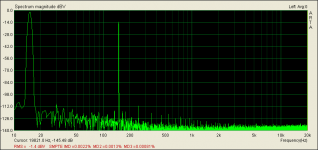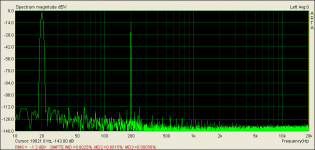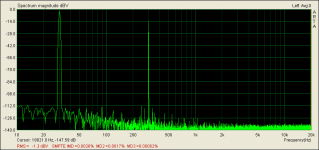looking forward to your findings and impressions
Would be very beneficial to measure classic vs. UltaBiB PSU and without vs. with decoupling using FFT like “before” and “after”. Otherwise, it is extremely subjective and intend to to turn to individuals psychoacoustics issue.
"Love Puts On A New Face" on the "Taming the Tiger" album for example.
You can take almost any song from the 70 / 80ies recordings. Joni Mitchell seemed to have had a very strong and intimate almost tribal connection to such bass lines spreading out into eternity, which is rather unusual for a female singer IMO. It came to me when I recently rediscovered Joni for me.
Even better probably would be, to try this simple mod and have a look what it can do to the favourite recordings of yours you may know well. Despite your aversion to tantals I'd suggest you to use them here for once, as IMO no other lytic comes close regarding stiff and stringent bass.
Effect should be even more pronounced with a split PS, as RC decoupling has rather limited isolation at the very bottom end of course.
Will be fun once I get there.
I listened to this song via Spotify on DCG3 and AKG 272HD. My DCG3 has single 317/337 followed by cap multiplier though.
Bass was "wobbly". But I would have just assumed that's the way it was produced if someone had not told me otherwise.
Not sure if it's synth bass or a stringed bass. But it's hard to tell what's going on with the bass. I do have AKG KXX (702-like) at home as well.
One of the biggest hurdles in trying to objectify sound perception by measurements is that we don't have a detailed dictionary yet as to how one translates into the other.Would be very beneficial to measure classic vs. UltaBiB PSU and without vs. with decoupling using FFT like “before” and “after”. Otherwise, it is extremely subjective and intend to to turn to individuals psychoacoustics issue.
Quite often we even don't have the words to describe a specific effect and are in need of analogies, others may or may not understand.
Unintended interaction between stages via power supply rail is extremely hard to measure too, as the frequencies of interest can be all over the place, down to very very low.
Best grip on the subject from my experience is, to look after power supply rejection ratio in SPICE and if not possible, just crank it up as high as any possible all through the audio band and even considerable below. This isn't any easy when pushed into the extremes.
Some of us are more listening to overtones, some are rather listening to the fundamentals as studies among musicians have shown. So perception of one and the same is quite different for different people.
Most albums from Joni seem to be excellent in this regard, especially given the time they were recorded. My guess is that she was a person that was very after that bass lines creating "her" space to act in.Bass was "wobbly". But I would have just assumed that's the way it was produced if someone had not told me otherwise.
But don't concentrate on this song I gave as an example, simply look out for the same behaviour on your favourite records. Try the mod and see what it does for you might be the best prove.
Those who praised the upgrade to the UltraBiB did already show the way to go. I'm sure sonics of salas amp can be pushed even further. To me it seems to be an extra ordinary capable design of great beauty, rewarding quite any improvement of the power supply.
By the way, got the BC237-40 and was able to sort out a matched quad at hfe 520.
Will make the switch tomorrow.
Last edited:
ohh, oh, oh, switching from BC560 to BC237-40 gives quite a remarkable gain in clear and focused sound, even down to the lowest department I'm so interested in.
Didn't need any break in, was apparent from the first notes. Great!
Might be, its partly synergistic with the tantal caps, haven't gone back and forth to sort this out.
Reverted to 100mA bias as the DCSG runs at temperatures I'm not really happy with in that open box I have for now.
Had no adverse effect as far as I can say by now.
Didn't need any break in, was apparent from the first notes. Great!
Might be, its partly synergistic with the tantal caps, haven't gone back and forth to sort this out.
Reverted to 100mA bias as the DCSG runs at temperatures I'm not really happy with in that open box I have for now.
Had no adverse effect as far as I can say by now.
Anyone use the Burson V5i in this?
Burson Audio V5i Opamps | Price & Reviews | Massdrop
Edit: oops wrong thread!
Burson Audio V5i Opamps | Price & Reviews | Massdrop
Edit: oops wrong thread!
Last edited:
Edit: oops wrong thread!
Alright, but accidentally it was not off topic
I listened to this song via Spotify on DCG3 and AKG 272HD. My DCG3 has single 317/337 followed by cap multiplier though.
Bass was "wobbly". But I would have just assumed that's the way it was produced if someone had not told me otherwise.
Not sure if it's synth bass or a stringed bass. But it's hard to tell what's going on with the bass. I do have AKG KXX (702-like) at home as well.
I just listened to JM's Love Puts On A New Face. I used the standard DCSTB+DCG3 combo but with BC327s in the current mirror and the 3W @ 32 Ohm HP output of my DAC to compare. I could hear an expansive "wobbly" bass carpet as it was probably meant in the production. But in both occasions, although rendered differently for overtones and presence, I could not hear a contraction of the song's overall image size whenever the bass line picked up. Overall on the DCG3 the song was much more present and sentimentally touching than on the source DAC's own HP output (aune S16) where it seemed laid back for expression and rather subdued for individual instruments and vocal clarity. Like when standing further back in a concert.
BTW now I am naturally listening to Jah Wobble seeking out possible bass wobbles 
Jah Wobble & The Invaders of the Heart Cosmic Love
Next is Marcus Miller: Dunlop Sessions Marcus Miller
Jah Wobble & The Invaders of the Heart Cosmic Love
Next is Marcus Miller: Dunlop Sessions Marcus Miller
Thanks a lot for your effort and sharing your findings.
Currently I'm fiddling with a setup to measure intermodulation by very low frequencies, say 150Hz -30dB overlayed by 15Hz -10dB.
Right from the DAC versus DCG3 out connected by Neutric EMC XLRs (Pin1 to chassis GND)
Reason is to get a better grip on the issue of interstage decoupling. Having had lowered the RC filter down to roughly 2Hz I still detect different presentation.
Next step I will do before the switch to the UltraBIB is to feed the first stage by a LT3045
Should be interesting.
same with my modified TEAC UD-H01.
But in contrast to your AUNE S16 the OPA1622 modified TEAC emphasises way too much on the highs as well
Currently I'm fiddling with a setup to measure intermodulation by very low frequencies, say 150Hz -30dB overlayed by 15Hz -10dB.
Right from the DAC versus DCG3 out connected by Neutric EMC XLRs (Pin1 to chassis GND)
Reason is to get a better grip on the issue of interstage decoupling. Having had lowered the RC filter down to roughly 2Hz I still detect different presentation.
Next step I will do before the switch to the UltraBIB is to feed the first stage by a LT3045
Should be interesting.
Overall on the DCG3 the song was much more present and sentimentally touching than on the source DAC's own HP output (aune S16)
same with my modified TEAC UD-H01.
But in contrast to your AUNE S16 the OPA1622 modified TEAC emphasises way too much on the highs as well
BTW now I am naturally listening to Jah Wobble seeking out possible bass wobbles
Currently I'm fiddling with a setup to measure intermodulation by very low frequencies, say 150Hz -30dB overlayed by 15Hz -10dB.
I fetched the notebook and the audio interface at the rack and I measured IMD SMPTE (4:1 bands ratio, RMS level near 1V) for 15Hz/150Hz 20Hz/200Hz 30Hz/300Hz. I don't see any worrying intermodulation % in all cases for stock DCSTB+DCG3 (100mA bias).
Attachments
The interface's line input as it is a measurement loop. Because buttoned up and on the rack I couldn't handily hang a resistor, and I wouldn't risk the AKG or the Sen open back diaphragms travel at 15Hz 1V RMS, but If you look in post#1 the swept THD figures don't worsen vs 1.5k line input when with 120 Ohm headphones as load for 100mA bias. To the contrary. Also in post #17 the 250Hz/8kHz standard SMPTE was 0.0027% with the AKG K612 PRO as load. In other words in the same low region % of very good results as with the above charts.
BTW the preamp's own feedback resistors at 750R apparent load to the line output are much harder a load than most line inputs found in gear.
BTW the preamp's own feedback resistors at 750R apparent load to the line output are much harder a load than most line inputs found in gear.
Hi Salas
I am powering the output relay from external psu and even increasing time between power on and relay closing I still get anoying pop in the speakers.
Worst when I power off.
I am considering placing an output muting circuit consisting of a 10ohm resistor shunting output to gnd while powering on and off.
What would be the best way to implement a muting circuit powered by an external psu ?
best
Ricardo
I am powering the output relay from external psu and even increasing time between power on and relay closing I still get anoying pop in the speakers.
Worst when I power off.
I am considering placing an output muting circuit consisting of a 10ohm resistor shunting output to gnd while powering on and off.
What would be the best way to implement a muting circuit powered by an external psu ?
best
Ricardo
The timing difference between PSUs won't help if the amp is holding much charge and its input stage type gets easily annoyed. Try rewire the relay like in post #3207 maybe its the best solution. You can hack the lanes underneath and redo with short wires. Low value resistor idea will potentially pull high current for a while through the small relay contacts either destroying them or prematurely aging them.
P.S. Or just move the relay on a mini sized matrix board and do the rewiring experiment there so to avoid hacks.
P.S. Or just move the relay on a mini sized matrix board and do the rewiring experiment there so to avoid hacks.
- Home
- Source & Line
- Analog Line Level
- Salas DCG3 preamp (line & headphone)


